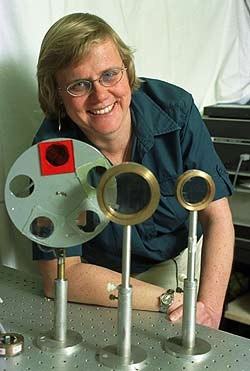2004 Hans and Marlies Zimmer International Scholar

Cornelia Bohne was born in São Paulo, Brazil, and studied chemistry at the Instituto de QuÃmica of the Universidade de São Paulo. She pursued her graduate studies at the same University under the supervision of Professor Giuseppe Cilento, where she studied the mechanism for the enzymatic generation of triplet excited states and the energy transfer from excited states to acceptors bound to biomolecules. She obtained her Ph.D. in 1987. As a post-doctoral fellow Dr. Bohne worked with Professor Tito Scaiano at the National Research Council of Canada and the University of Ottawa. During this period she studied the photochemistry of compounds in homogenous solution and in microheterogeous systems, such as reversed micelles, cyclodextrins and cells.
In 1992 Dr. Bohne accepted a position as Assistant Professor at the Department of Chemistry, University of Victoria. She obtained tenure and was promoted to Associate Professor in 1997 and to Full Professor in 2000. In 1998/99 Dr. Bohne was an Alexander von Humboldt Research Fellow at the Fritz-Haber Institut der Max-Planck Gesellschaft in Berlin, working with Professor Josef Holzwarth.
Dr. Bohne's research interests are in supramolecular dynamics. Supramolecular architectures are organized by intermolecular forces between components, and can achieve functions that are not possible for the individual building blocks. In contrast to molecular chemistry, supramolecular systems are always reversible, and dynamics are essential to achieve function. Dr. Bohne's long-term goal is to bring the understanding of supramolecular dynamics to the same level as its structural aspects. Knowledge of the underlying concepts for supramolecular dynamics is vital to fulfill the longstanding promise that these systems can lead to functions inaccessible to molecular chemistry. In her studies Dr. Bohne measures events in real-time, using fast kinetic techniques, including laser flash photolysis, stopped-flow and laser temperature-jump experiments. For each supramolecular system her group develops the required methodology to measure dynamics in real-time, establishes the relationship between dynamics and structure of the supramolecular building blocks, and applies this knowledge to design new supramolecular functions. The supramolecular systems currently under investigation are cyclodextrins, bile salt aggregates, DNA and proteins.
Dr. Bohne has served in several peer review capacities. From 1999 to 2002 she was a member of the Inorganic-Organic Grant selection committee (one of the two national committees in chemistry) at the Natural Sciences and Engineering Research Council of Canada, and she chaired the committee for the 2001-2002 grant competition. She is currently Associate Editor of Photochemistry and Photobiology and is on the Editorial Advisory Board of Langmuir. At the administrative level, Dr. Bohne has recently served as the acting chair of the Chemistry Department from July to December 2002.
Other scholarly activities include Dr. Bohne's involvement in the Inter-American Photochemistry Society as a former member of the advisory board, current Canadian treasurer, member of the several organizing committees for IAPS conferences, and as co-chair of the IAPS conference in 2004. She is also involved in IUPAC as a member of the Canadian National Committee for IUPAC and as a member of the IUPAC Sub-Committee on Photochemistry. Dr. Bohne is a founding member of the Reactive Intermediate Student Exchange program.
Her other interests are sailing, travelling and reading.
Dynamics in Supramolecular Chemistry: How can we understand function and complexity
Cornelia Bohne, Department of Chemistry, University of Victoria, BC, Canada
One of the quests of supramolecular chemistry is to achieve function that is not accessible by using the individual building blocks of theses systems. Supramolecular architectures are always reversible. Therefore, in contrast to molecular chemistry, the dynamics of supramolecular systems are essential to achieve function. We study the dynamics of these systems by measuring kinetics in real-time. By understanding the dynamics of each system we can then manipulate it to achieve or enhance a desired function. A second objective is to understand how an increase in structural complexity affects the dynamics of supramolecular systems. The dynamics of host-guest complexes with cyclodextrins, including complexes with more than one host molecule, and the binding of guests to bile salt aggregates will be presented.